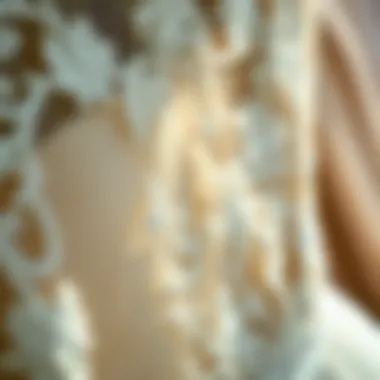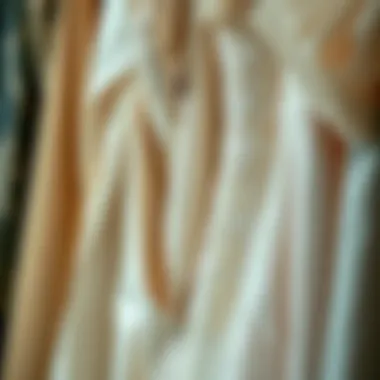Laundry Care for Wedding Dresses: A Complete Guide


Intro
Wedding dresses, often cherished as the crown jewels of a bridle’s attire, serve not just as a fabric but as a memory stitched in time. A wedding day marks an important chapter in many lives, and the dress worn often encapsulates dreams, hopes, and moments that last a lifetime. Thus, maintaining its integrity, beauty, and vibrancy is paramount for anyone who wishes to cherish these pieces beyond the wedding day.
In this journey through laundry care, we’ll peel back the layers on how to properly care for wedding dresses. We’ll dissect the complexities of different fabric types, delve into cleaning techniques, both at home and professionally, and shine a light on preservation methods to keep the magic alive for generations to come. For brides and caretakers alike, this guide will be your trusted companion as you navigate the delicate waters of wedding dress care.
Trending Styles
Modern Minimalism
In the age of modern minimalism, the focus has switched to clean lines, elegant silhouettes, and simplicity infused into every thread. Dresses crafted from airy fabrics like chiffon or silk gain a lot of attention, yet, proactively caring for these delicate garments is essential to retain their charm. When laundering these fabrics, it’s crucial to opt for gentle, pH-neutral detergents that honor the fragility of the material. Hand washing or using a gentle cycle in cold water is often recommended, ensuring the dress doesn't become a wrinkled mess.
Cozy Rustic
Conversely, the cozy rustic trend breathes life into vintage elements, often spotlighting lace, tulle, and other textured fabrics. Cleaning such dresses can be a careful balance between preserving their original elegance and ensuring a thorough cleanse. Spot treating stains as soon as possible is vital to prevent discoloration. If the dress embraces earthy hues, a solution of vinegar and water can be an excellent natural alternative to commercial cleaners.
Color Palettes
Calming Neutrals
Neutral tones dominate in the world of wedding attire. Shades like ivory, champagne, and soft blush have a timeless elegance that’s hard to beat. The key to maintaining these shades lies in meticulous attention to detail while washing. Always check the manufacturer's instructions, and avoid exposing the dress to harsh sunlight while drying, as this can alter its color.
Bold Accents
For those choosing bold accents, multicolored elements can add a refreshing twist to traditional designs. However, with colors comes the risk of bleeding. Laundry care becomes a protective act—using cold water and color-safe detergents will help mitigate this risk, ensuring the wedding dress remains vibrant and striking.
Remember: "A well-cared-for dress can tell a story beyond the day it was worn, resonating with memories that will last a lifetime."
In the following sections of this guide, we will explore the intricate processes of cleaning, professional options, and preservation techniques that should not be overlooked. The goal is to empower brides and custodians alike, ensuring every piece remains as stunning as the moment it was first donned.
Understanding Wedding Dress Fabrics
When it comes to wedding dresses, understanding the fabrics is paramount. Not only do they contribute to the aesthetic appeal of the garment, but they also influence how the dress behaves, reacts to cleaning processes, and ultimately withstands the test of time. Each fabric has its unique set of characteristics, which informs the care methods that should be used to maintain their beauty. Prioritizing this knowledge helps brides make informed choices, ensuring that their cherished dress stays stunning in every chapter of its journey.
Common Fabrics Used in Wedding Dresses
Silk
Silk is often regarded as the epitome of luxury in the wedding dress world. Its smooth, lustrous surface creates a romantic drape that's hard to resist. One of the key characteristics of silk is its ability to reflect light beautifully, giving the dress an ethereal quality. However, silk is also delicate, making it a fabric that requires careful handling. While it adds elegance, it can easily show watermarks or stains if not treated properly, so being cautious is a must.
Tulle
Tulle is that enchanting lightweight netted fabric that often overlays wedding gowns and adds a whimsical touch to any design. Known for its voluminous appearance without much weight, tulle creates that dreamy fairytale look. However, it is crucial to note that tulle can snag easily. Thus, while it’s a popular choice for adding detail, it demands gentle care to maintain its integrity through every wear and laundering process.
Lace
Lace brings an intricate and timeless beauty to wedding dresses through its delicate patterns. Its airy quality allows for a romantic touch, echoing tradition and whimsy alike. The intricacy of lace differs vastly; some types are sturdy while others are flimsy. Bridal lace, like Alençon or Chantilly, deserves special attention, especially regarding care to avoid tears and damage over time. Therefore, understanding the specifics of the lace used can significantly influence how it is cleaned.
Organza
Organza is a crisp, sheer fabric that often offers structure to a wedding gown, typically seen layered underneath softer materials. This fabric’s beautiful ability to hold shape without adding bulk makes it a favorite among designers. However, its tendency to wrinkle if care isn’t taken, can be a double-edged sword; while its structure is stunning, it can also be a bit demanding when it comes to laundering and storing.
The Importance of Professional Cleaning
When it comes to wedding dresses, the stakes couldn't be higher. These garments often embody not just fashion but also deep sentimental value. That’s where professional cleaning steps in, ensuring each gown is treated with the utmost care and precision.
Why Professional Services Matter
Expertise in Delicate Fabrics
Wedding dresses are typically crafted from materials that are softer than a gentle whisper. You’ll find luxurious silk, airy tulle, intricate lace, and delicate organza, each fabric demanding unique handling. Professionals know how to handle these exquisite materials without resulting in damage. They are trained to recognize how each fabric reacts to water, detergents, and even steam. For instance, using the wrong method on silk might lead to loss of sheen or even fabric breakage. In essence, leveraging professionals' expertise is like hiring a skilled musician to play a priceless instrument: only a master can bring out the true beauty.
Proper Stain Removal Techniques
Stains on wedding dresses come in all shapes and colors. From red wine splatters to accidental food smudges, these blemishes can be quite tenacious. Professional cleaners possess the tools and techniques required for effective stain removal. They utilize solutions that target specific stains without compromise to the fabric. Unlike DIY methods, which sometimes do more harm than good, professional stain removal can mean the difference between a destroyed gown and a restored treasure.
Guaranteed Preservation
After the vows are spoken and the reception is over, preserving a wedding dress becomes paramount. Professional cleaning guarantees that the gown is not only clean but also preserved for future generations. Specialized preservation techniques can maintain the dress's beauty while avoiding yellowing, fabric deterioration, or fading. It’s a solid investment, ensuring that the dress remains as stunning down the line as it was on the wedding day.
Finding a Reputable Cleaner
Choosing the right cleaner is just as vital as the cleaning process itself. A poorly chosen service can lead to devastating results.
Researching Credentials
Before entrusting your dress, invest some time in researching a cleaner's credentials. Look for professionals that have training certifications, particularly in fabric care and preservation techniques. This is not merely a formality; it assures clients that the cleaners have in-depth knowledge and ethical practices.
Advantages of researching credentials include:


- Assurance of quality service
- Awareness of proper cleaning methods
- Reduced risk of damage to your garment
Customer Reviews and Testimonials
Another valuable step in selecting a cleaner is examining customer feedback. Reviews often reveal insights that credentials cannot. Look for testimonials that speak to successful stain removal experiences and successful preservation stories.
Benefits of considering customer reviews:
- Real-life experiences give perspective on service quality
- Positive testimonials enhance trust in the service
- Red flags in reviews can prevent costly mistakes
Consultations Before Cleaning
Consulting with the cleaner before proceeding with the service allows you to gauge their understanding of your dress’s specific needs. It also offers a chance to ask any burning questions you may have. A friendly, informative consultation means they're likely not just out to make a quick buck but are genuinely invested in their service.
Benefits of consultations include:
- Clarity on care process tailored to your dress
- Opportunity to express concerns directly
- Building a rapport with the cleaner, enhancing confidence in their abilities
Choosing professional cleaning services is not just about ensuring cleanliness. It's a critical step in preserving the memories encapsulated within that dress, ensuring its beauty stays as timeless as the love story it represents.
DIY Laundry Tips for Wedding Dresses
Taking care of a wedding dress on your own can seem like a daunting task. However, with the right know-how and a careful approach, many brides can maintain their gowns in beautiful condition. DIY laundry tips provide a way to preserve the dress while avoiding the potential expense of professional cleaning services. This section covers some essential steps one can take to ensure that the gown remains pristine after the big day.
Preparing the Dress for Washing
Before diving into the actual washing of the dress, it’s vital to prepare adequately. Proper preparation helps to avoid any mishaps during the cleaning process. Here are the critical points to focus on:
Checking Labels and Care Instructions
One of the first things any bride should do before washing her wedding dress is to check the label and care instructions. Most gowns have care labels sewn into the hem or lining, detailing how they should be washed. This might include guidance on temperature settings, whether dry cleaning is necessary, or even if it can handle machine washing. Ignoring these instructions can lead to irreversible damage.
Some dresses, particularly those made from silk or intricate lace, are best handled with the utmost care. It's crucial to note that different fabrics require different approaches, making this step beneficial for ensuring the longevity and beauty of the gown. By following the manufacturer's guidelines, you're setting the stage for successful cleaning. So, don’t skip this step; it’s like reading the fine print before signing a contract.
Inspecting for Damage
The next critical step is inspecting the dress for any damage, such as tears, loose beads, or significant stains. This inspection plays a vital role in determining how to proceed with the washing process. Each flaw can significantly affect the outcome. If there's visible damage, it might be wise to consult a professional cleaner before attempting any DIY remedy.
The advantage of inspecting the dress closely is that it allows for targeted cleaning efforts on troubled areas instead of potentially causing more harm. It’s essential to take a meticulous approach, as what might appear as a small snag could lead to a bigger problem if not addressed properly. Think of it like looking for cracks in a foundation; better to spot them early than to wait until they become a major issue.
Removing Accessories
Wedding dresses often come adorned with various accessories, from belts to intricate veils. Before washing, it’s vital to remove these items, as they can snag on the fabric, causing bends and tears during the laundering process. Additionally, many accessories may have different care requirements than the dress itself.
This step not only protects the gown but also allows for ensuring that every element of the dress is cared for properly. Some accessories may require different cleaning methods, so by detaching them, you are also saving future headaches. It's like packing a delicate item for a trip; every piece should be handled with care to avoid any mishaps along the way.
Gentle Washing Techniques
After preparing the dress, the next phase involves the actual washing techniques. Understanding the nuances of how to wash a wedding dress is key for preserving its elegance.
Hand Washing vs. Machine Washing
When it comes to washing options, hand washing is generally considered the safer route for delicate wedding dresses. It allows for more control over the cleaning process, reducing the risk of damaging the fabric or embellishments. Typically, this method is less abrasive than machine washing, which can cause fraying or fading over time. However, if the dress is labeled as machine washable, it's essential to use the gentle cycle and a mesh garment bag. This balance allows for a feasible compromise between convenience and care.
The beauty of hand washing lies in the personal touch it brings to the gown's cleaning journey. It's much like nurturing a plant; the more attention you give, the better the result.
Choosing the Right Detergent
Selecting an appropriate detergent is crucial for the care of a wedding dress. Often, a mild, pH-balanced detergent designed for delicate fabrics is recommended. This choice minimizes the risk of harsh chemicals causing damage or discoloration. Similar to how one would choose a gentle soap for sensitive skin, the right detergent can help maintain the dress's integrity.
Additionally, there are products specifically formulated for delicate or high-end fabrics, which can be a solid investment for those who want to ensure that their gown remains vibrant and beautiful after every wash.
Temperature Settings and Water Type
When washing a wedding dress, it is important to consider the water type and its temperature. Most fabrics fare best in cool to lukewarm water, as hot water can promote shrinkage or fading in certain materials. Using distilled water can further mitigate risks associated with local water impurities.
The advantage of adhering to these settings is that they help maintain the color and shape of the dress. You wouldn't throw a cashmere sweater in boiling water, so applying the same logic to a treasured wedding gown is just plain commonsense.
Drying and Storing Steps
Once the washing is complete, the drying and storing steps come into play. Both are essential for prolonging the life and beauty of the wedding dress.
Avoiding Direct Sunlight
After washing, it's critical to dry the dress away from direct sunlight. Sunlight can act like a bleaching agent, causing colors to fade over time. Ideally, the dress should dry in a shaded, airy space, allowing it to air dry naturally. This way, you walk the line between efficient drying and fabric preservation. Think of it as giving your dress a relaxing spa day instead of rushing through stressful conditions.
Air Drying Techniques
Air drying is often the safest method for ensuring that delicate fabrics retain their form. Laying the dress flat on a clean, dry towel can help preserve its shape while it dries. Hanging can also be an option for certain fabrics, but be cautious of stretching.


Utilizing air drying prevents the risk of heat damage that comes with using a dryer. It allows for a gentler finish and upholds the quality of the fabric, resulting in a polished look.
Proper Folding and Storage
Once the dress is entirely dry, proper folding and storage become paramount. It's best to store the gown in a breathable garment bag made of cotton or muslin. Avoid plastic bags, as they can trap moisture and cause mold or mildew to develop.
Folding the dress carefully and avoiding pressure on detailed areas will ensure its structure remains intact. Storing the dress properly is akin to preserving a piece of art; the right conditions keep it beautiful through the ages.
Remember, the care given today affects how future generations will view and cherish your wedding dress. Treat it with the same reverence as the day it was adorned.
Stain Removal Strategies
Stains on wedding dresses can be a nightmare for any bride. Whether from a celebratory toast or a spilled appetizer, dealing with these unwelcome surprises is essential to maintaining the elegance of the gown. Understanding proper stain removal strategies ensures that precious memories aren’t overshadowed by unsightly marks. This section addresses common culprits, presents homemade remedies, and evaluates commercial options, providing the knowledge necessary to safeguard your dress's beauty.
Identifying Common Stains
Understanding what types of stains can occur during the wedding festivities can arm you with the knowledge to tackle them effectively.
Wine
Wine is often at the center of wedding celebrations, but it can be a not-so-fun surprise when it ends up on a wedding dress. Its vibrant pigments can seep into fabric, making it a daunting adversary for any cleaner. The key characteristic of red wine is its deep color, which can be incredibly persistent on lighter fabrics like satin or silk.
Before making any moves, act fast. Blot the stain gently with a clean cloth; scrubbing can spread the stain further, and nobody wants to add stress to their big day. A common tip is to sprinkle salt on the stain to absorb moisture and then rinse with cold water, which might help lift the initial stain.
Food
Food stains can come from unexpected places: a crumbed dessert, a bright sauce, or even a short-lived taste of joy from the wedding pie. Often, food stains can vary widely in nature, from oily residues to colorful sauces. This variability makes them tricky. Food stains also demand quick action. If possible, avoid touching the stained area with your hands, as oil from your fingers can worsen the damage.
Makeup
Makeup is an undeniable part of looking stunning on your big day. However, the risk of smudges and spills exists. A foundation or lipstick stain can leave an indelible mark if not treated properly. The waxy nature of many makeup products poses a unique challenge for staining. The best approach is to dab the spot with a makeup remover or a gentle soap solution. It’s a good practice to test on an inconspicuous area first to prevent further damage.
Grass
Grass stains might seem trivial, but they can pop up from a spontaneous dance or a moment close to nature. The vibrant green can cling stubbornly to fabric fibers. The chlorophyll in grass is the main culprit behind the infamous green stain. To treat it, rinse with cold water and use a soap solution to break down the stain. The straightforward nature of this approach makes it a favorite among brides who want to salvage their dresses after outdoor ceremonies.
Homemade Stain Remedies
Homemade remedies can be a lifesaver when dealing with stains on treasured wedding dresses. They are often cost-effective and gentler on delicate fabrics compared to harsh commercial cleaners.
Vinegar and Baking Soda
Vinegar and baking soda form a powerful duo against stains. The acidity of vinegar helps break down the stain, while baking soda acts as a mild abrasive, effectively lifting the remnants without damaging the fabric. This combination is particularly effective for stubborn food stains. Mix equal parts of baking soda and vinegar to create a paste, apply it to the stain, and let it sit before gently rinsing. However, be cautious with delicate fabrics, as you don’t want to damage those fibers.
Soap Solutions
Soap solutions can clean almost anything, especially when mixed with water. Opt for a mild soap, like a gentle dish soap, to create a solution for treating stains. This remedy is effective for a wide range of stains since soap can lift dirt and residues easily. Mix a few drops with water and gently work it into the stained area, blotting as you go. This method is straightforward and usually provides good results without the risk of chemical damage.
Commercial Stain Removers
While homemade solutions are wonderful, sometimes you need a bit of extra power. Commercial stain removers are designed to tackle a variety of stains, including stubborn ones. They contain specific ingredients that target various types of stains, and many brands have products specifically for delicate fabrics or wedding gowns. Read the labels carefully; some might be too abrasive for laces or silk. Using a commercial stain remover can give you peace of mind, but proper application is essential to avoid damaging the gown.
Preservation Techniques for Wedding Dresses
When it comes to wedding dresses, preservation is not just a practical concern; it’s a way to safeguard cherished memories. These gowns symbolize joy and life-long commitments, making their care essential. Understanding the proper preservation techniques can extend the life of the dress, ensuring it remains as beautiful as the day it was worn. This section sheds light on effective long-term storage solutions and how to prepare the dress for future generations.
Long-term Storage Solutions
Long-term storage is vital, especially for pieces that have sentimental value. Properly stored, a wedding dress can withstand the test of time, preventing wear and tear caused by environmental factors.
Using Acid-Free Materials
Using acid-free materials is a cornerstone of dress preservation. Acid can degrade fabrics over time, leading to discoloration and damage. Acid-free tissue paper is commonly recommended for interlaying between layers of the gown during storage. This protects delicate fabrics like silk and lace from staining or breaking down.
The beauty of acid-free materials lies in their neutral pH, making them an excellent choice for preserving dresses. They minimize the risk of yellowing, extending the lifespan of the gown significantly. However, it is crucial to ensure that any storage boxes or bags used are also acid-free; otherwise, the whole purpose is defeated.
Choosing the Right Storage Box
Choosing the right storage box is just as important as the materials inside it. A solid, breathable box can protect the dress from dust, insects, and light exposure. Many experts suggest using a box made of sturdy cardboard, designed specifically for garment storage.
A well-constructed box will typically be both functional and aesthetically pleasing, providing a safe place for the gown while also serving as a display piece if desired. Remember, while cheap boxes might save you some money, they could lead to regrets down the line if they warp or fail to provide the necessary protection.
Climate Control Considerations
Climate plays a significant role in preservation. High humidity can lead to mold and mildew, while extreme dryness can cause fabrics to become brittle. Ideally, the storage space should have a stable temperature and humidity level, away from direct sunlight. A cool, dark area with low moisture is most beneficial.
Additionally, using silica gel packets can help absorb excess moisture in the storage environment, further protecting the fabric. Caring for your dress in a controlled environment not only helps in maintaining its color but also keeps the structure intact, which is essential for such a delicate garment.
Preparing for Future Generations


Preserving a wedding dress isn’t just about physical care; it’s also about securing the emotional heritage it carries. As generations pass, being able to share the dress’s story becomes part of its value. This section discusses how to document this history effectively and pass down care instructions to family members.
Documenting the Dress History
Documenting the dress history is an often-overlooked aspect of preservation. It's a chance to leave behind a piece of family lore. By recording where the dress was bought, the story of the wedding day, and any special moments associated with it, you create a narrative that can be shared with future generations.
Consider including photographs of the dress in its original context—perhaps on the wedding day or during a fitting. Tying a personal story to the fabric enriches its significance, transforming the dress from merely a beautiful item into a treasured heirloom.
Passing Down Care Instructions
Passing down care instructions is crucial for the longevity of the dress. What worked for one generation may not be known to the next. Clearly outlining how to maintain the dress is part of responsible stewardship. Simple care tips can be written down and stored with the garment, or shared during family gatherings.
This ensures that the new caretakers are equipped with knowledge that protects the dress while also maintaining its sentimental value. Encourage them to review this information regularly, ensuring it remains relevant and easily accessible.
Creating a Family Tradition
Creating a family tradition around the wedding dress can instill a sense of pride and connection. Whether it’s through an annual gathering where family members share stories about their weddings, or even wearing the dress for special occasions, these rituals can breathe new life into the gown.
The act of passing down a wedding dress becomes a journey, not just an object. Such traditions elevate the significance of the dress, making it not just a keepsake but a living part of the family's history. This personal attachment can also contribute to the care and attention it receives, safeguarding its future for generations to come.
Cultural Considerations in Dress Care
Caring for wedding dresses goes beyond just doing laundry; it encompasses a respect for the cultural significance embedded in these garments. Wedding dresses often carry deep-rooted traditions, which vary widely across different cultures. Understanding these cultural considerations not only enriches the approach to maintenance but also helps in preserving stories of love, heritage, and craftsmanship.
Different Traditions and Practices
American Customs
In the United States, wedding dresses are traditionally white, a color that symbolizes purity and new beginnings. The trend started in the 19th century when Queen Victoria wore a white gown for her wedding to Prince Albert. This choice has trickled down to modern brides who often choose white or ivory dresses. American customs emphasize preservation through careful cleaning and storage, typically involving professional services to maintain the dress's brilliance. An advantage of such practices is the assurance that the dress will remain pristine for future generations, allowing it to be a cherished heirloom. However, sourcing skilled cleaners can sometimes pose a challenge, requiring diligence from brides to ensure their dress's safety.
International Perspectives
Across various cultures, wedding attire exhibits astonishing diversity, and it is not always about white dresses. In India, for instance, brides often wear vibrant reds or golds, rich with symbolism tied to prosperity and fortune. Looking at international perspectives sheds light on the different care practices required by diverse materials or embellishments. These dresses tend to demand specialized cleaning solutions suited for intricate beadwork or luxurious silks. The unique feature of this approach lies in understanding that cleaning methods should reflect the cultural context; what works for one might not for another. This understanding ensures that dresses retain their symbolic meanings without risking damage during care.
Evolution of Dress Care
Dress care has transformed significantly over the years, influenced by advancements in cleaning technology and a growing awareness of environmental impact. In the past, many brides relied on household remedies, but there’s been a marked shift toward eco-friendly products and sustainable practices. This evolution may benefit the article by highlighting modern techniques that not only preserve the dress's beauty but also respect the planet. Among the cons, the new technology may occasionally overlook traditional methods that have proven effective over decades. Recognizing these differences allows caretakers to make informed choices about how best to maintain these significant garments.
Respecting Cultural Significance
Understanding Heritage
Understanding heritage encompasses more than just the materials and styles of wedding dresses; it dives into the stories behind them. Each dress holds historical value that speaks to individual family traditions or wider cultural narratives. Documenting the history of a dress often involves recording the lineage of its wearers and the stories they carry. This practice is beneficial as it fosters a sense of pride and connection to one’s roots, enhancing the emotional value of the garment. However, not all caretakers may think to document such heritage, leading to forgotten stories that diminish the dress's significance over time.
Significance in Ceremonies
In various cultures, wedding dresses play pivotal roles during ceremonies, often symbolizing rites of passage. For example, in Chinese culture, a red dress is worn to attract luck and happiness, playing an integral role in the marriage celebration. These elements contribute immensely to the overall understanding of dress care. Preserving these dresses through thoughtful cleaning practices ensures that they remain vibrant and representative of the culture's values. On the downside, it can be complicated for caretakers unfamiliar with ceremonial significance to choose appropriate care methods, potentially leading to mishaps.
Preservation as a Cultural Act
Preservation in this context is seen as an act of cultural respect. It speaks to the notion that garments are not merely fabric but imbued with memories and traditions that transcend generations. As wedding dresses often symbolize pivotal moments in a family's history, the act of preserving them ensures that future generations can appreciate their origins. The unique feature of viewing preservation as a cultural act lies in promoting responsible practices that inform and educate caretakers about the true value of these garments. Still, some may perceive this approach as overly sentimental, failing to recognize the importance of maintaining cultural legacies.
Keeping in mind that every stitch of fabric tells a story can transform the way one approaches dress care, turning a task into a tribute to love and tradition.
Epilogue
Caring for wedding dresses is not just about the day of the wedding but extends far beyond. The importance of proper care for these garments cannot be overstated. These dresses often carry immense sentimental value; they encapsulate memories, emotions, and stories that are passed down through generations. Proper laundering and preservation techniques are essential to maintaining this value and ensuring that these treasured items remain in pristine condition.
First and foremost, investing time in understanding the nuances of fabric types can prolong the life of a dress. Each fabric, from luxurious silk to delicate lace, behaves differently when exposed to various cleaning methods. By learning about the specific needs of each fabric, individuals can avoid damage and enhance the garment’s longevity.
"A well-cared-for wedding dress is like a time capsule, preserving not just the fabric, but the very essence of a moment in time."
Additionally, the role of professional cleaning services cannot be understated. Expertise in delicate fabrics ensures that organic stains are effectively managed without compromising the garment's integrity. Entrusting a wedding dress to a professional also means utilizing techniques that individuals may not have at their disposal. This is vital for garments that will be cherished for years to come. Performing diligent research to find reputable cleaners can be a game-changer for on-going garment care.
Lastly, preserving a wedding dress responsibly means creating a legacy. This involves not only storing it properly but also documenting its history. Providing care instructions allows future generations to appreciate and uphold the same values. In doing so, individuals cultivate a sense of connection that transcends time.
In summary, maintaining the beauty and integrity of a wedding dress through proper care is an act of love and respect, both for the garment and the memories it evokes. Every bride deserves to honor that special day, and through conscientious decisions regarding laundry and preservation, she can ensure that her wedding dress remains a shining testament to that unforgettable moment.
The Lasting Value of Proper Care
The lasting value of proper care is not merely a statement but a reality engrained in the fabric of how we perceive and cherish wedding dresses. These dresses encapsulate some of the most pivotal moments in our lives. They symbolize commitment, joy, and family. Hence, the care invested in preserving these garments reflects the importance we place on these values.
Proper care provides tangible benefits. It prevents yellowing, festering stains, and thread damage, which can transform a once-majestic garment into a shell of its former self. Taking proactive measures like using acid-free materials for storage or seeking professional cleaning can keep a wedding dress looking as radiant as it did on its special day.
Moreover, the emotional impact cannot be discounted. A wedding dress cared for well allows bridesmaids and future daughters to experience the same magic. Passing down a well-preserved dress can forge familial bonds and impart traditions that endure.
Ultimately, investing in proper care allows individuals to derive ongoing joy from their wedding dresses, transforming them from simple items of clothing into cherished artifacts brimming with history and significance.
Encouragement for Responsible Preservation
In today’s world, acknowledging the importance of responsible preservation goes hand in hand with the joy of owning a wedding dress. This process is larger than just washing and storing; it is about honoring a legacy. Future generations will look to these garments, not just to wear, but to understand their heritage. By being mindful of preservation practices, individuals can ensure their wedding dresses remain accessible and visually stunning for those who follow.
Engaging in this responsibility means taking a proactive approach to care. Learning about environmentally friendly cleaning options, staying informed about proper storage techniques, and regularly inspecting for any signs of wear are all critical components of preservation. It shows a commitment not just to the garment, but also to the memories and love it represents.
Documentation is another practical step. Keeping records of how and when the dress was worn, along with care instructions and even anecdotes from the wedding day can make the dress even more meaningful for future generations. It enhances the narrative, allowing stories to unfold in tandem with the dress itself.
Taking these steps is simple but effective. A wedding dress serves as a canvas of love, adventure, and shared history. Through responsible preservation, it not only retains its beauty but becomes a bridge connecting past, present, and future. Each dress can hold a narrative, and preserving it responsibly means ensuring these stories continue to be told.















